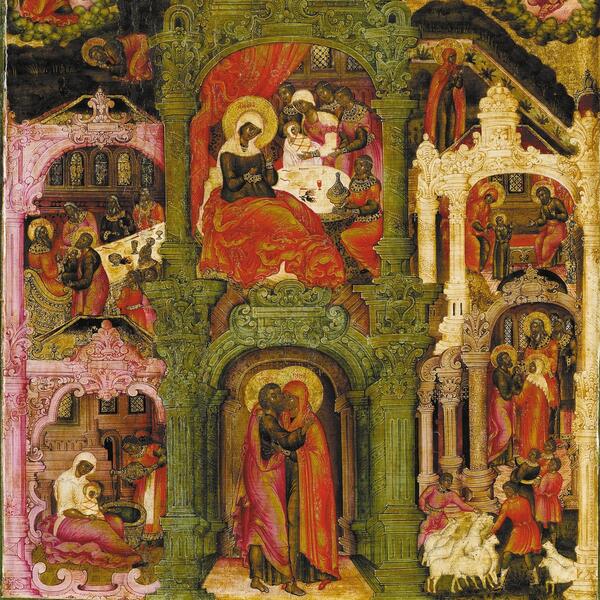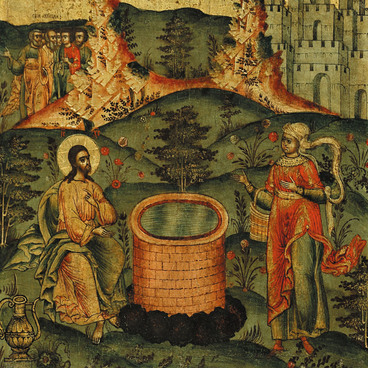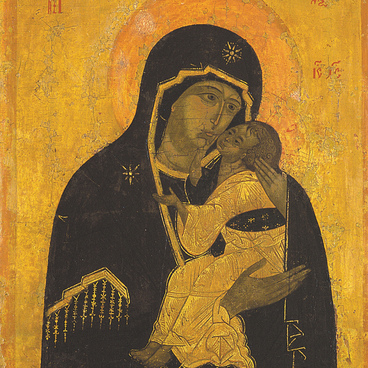The Church started celebrating the Nativity of Mary in the 7th century, but due to the long period of iconoclasm, its iconography only formed in the 9th century.
The life of the Virgin Mary before the Annunciation is described in the Protoevangelium of James and the Gospel of Pseudo-Matthew.
Mary’s father, Righteous Joachim, was descended from King David who had received a promise from God that the Savior would be born in his family. The righteous Joachim and Anne were childless until a very advanced age, but they trusted in the Lord. Once, Reuben, the high priest of Jerusalem, refused to accept Joachim’s sacrifice because he believed a man without offspring to be unworthy of such honor. The old man was desolate and went to the desert with his herd, while his wife remained at home, and they both prayed about having a child, promising to dedicate the child to God. Their prayers were answered. An angel appeared to the couple and announced to them that their child will be known all over the world.
Until Mary was three years old, the parents brought her up at home. They not only loved her as their daughter but also worshiped her as their Lady, while she filled them with the grace of God. The righteous parents of the Virgin Mary passed away before the Annunciation.
The iconography of the Nativity of Mary changed over time, reflecting the historical context and ethical standards of the time, and also indicating that the icon painters of the late Middle Ages strove to adhere to the narration and create detailed scenes.
For example, early icons did not portray Saint Joachim because, according to the traditions, he was not allowed to enter the part of a building set apart for women. Later, he was depicted in the door or window opening, and eventually — beside his wife and daughter.
Saint Anne is depicted in the center of the painting, surrounded by maidens and women bringing gifts. Initially, these offerings were only a ritual but over time they also acquired a more literal meaning. The Child Mary is wrapped in white cloths which designate purity, innocence, and holiness. Down below is the image of two saints, Joachim and Anne, who symbolize marital fidelity and love. On either side are scenes that preceded the Nativity of Mary. They are characterized by unusual reading rules: at first, the upper scenes are read (the prayers of Joachim and Anne, and the appearance of an angel), then the bottom ones (their meeting at the Golden Gate after learning Anne will bear a child, and ablution of Mary), and finally the ones in the middle (the feast organized by Joachim for priests, and the conversation between the parents and their daughter).
In the Orthodox Church, the Nativity of Mary is one of the Twelve Great Feasts. This icon was painted by the brotherhood of Gury Nikitin for the feasts tier of the iconostasis in the side altar of Barlaam of Khutyn, which was located at the Church of Elijah the Prophet.
The life of the Virgin Mary before the Annunciation is described in the Protoevangelium of James and the Gospel of Pseudo-Matthew.
Mary’s father, Righteous Joachim, was descended from King David who had received a promise from God that the Savior would be born in his family. The righteous Joachim and Anne were childless until a very advanced age, but they trusted in the Lord. Once, Reuben, the high priest of Jerusalem, refused to accept Joachim’s sacrifice because he believed a man without offspring to be unworthy of such honor. The old man was desolate and went to the desert with his herd, while his wife remained at home, and they both prayed about having a child, promising to dedicate the child to God. Their prayers were answered. An angel appeared to the couple and announced to them that their child will be known all over the world.
Until Mary was three years old, the parents brought her up at home. They not only loved her as their daughter but also worshiped her as their Lady, while she filled them with the grace of God. The righteous parents of the Virgin Mary passed away before the Annunciation.
The iconography of the Nativity of Mary changed over time, reflecting the historical context and ethical standards of the time, and also indicating that the icon painters of the late Middle Ages strove to adhere to the narration and create detailed scenes.
For example, early icons did not portray Saint Joachim because, according to the traditions, he was not allowed to enter the part of a building set apart for women. Later, he was depicted in the door or window opening, and eventually — beside his wife and daughter.
Saint Anne is depicted in the center of the painting, surrounded by maidens and women bringing gifts. Initially, these offerings were only a ritual but over time they also acquired a more literal meaning. The Child Mary is wrapped in white cloths which designate purity, innocence, and holiness. Down below is the image of two saints, Joachim and Anne, who symbolize marital fidelity and love. On either side are scenes that preceded the Nativity of Mary. They are characterized by unusual reading rules: at first, the upper scenes are read (the prayers of Joachim and Anne, and the appearance of an angel), then the bottom ones (their meeting at the Golden Gate after learning Anne will bear a child, and ablution of Mary), and finally the ones in the middle (the feast organized by Joachim for priests, and the conversation between the parents and their daughter).
In the Orthodox Church, the Nativity of Mary is one of the Twelve Great Feasts. This icon was painted by the brotherhood of Gury Nikitin for the feasts tier of the iconostasis in the side altar of Barlaam of Khutyn, which was located at the Church of Elijah the Prophet.



